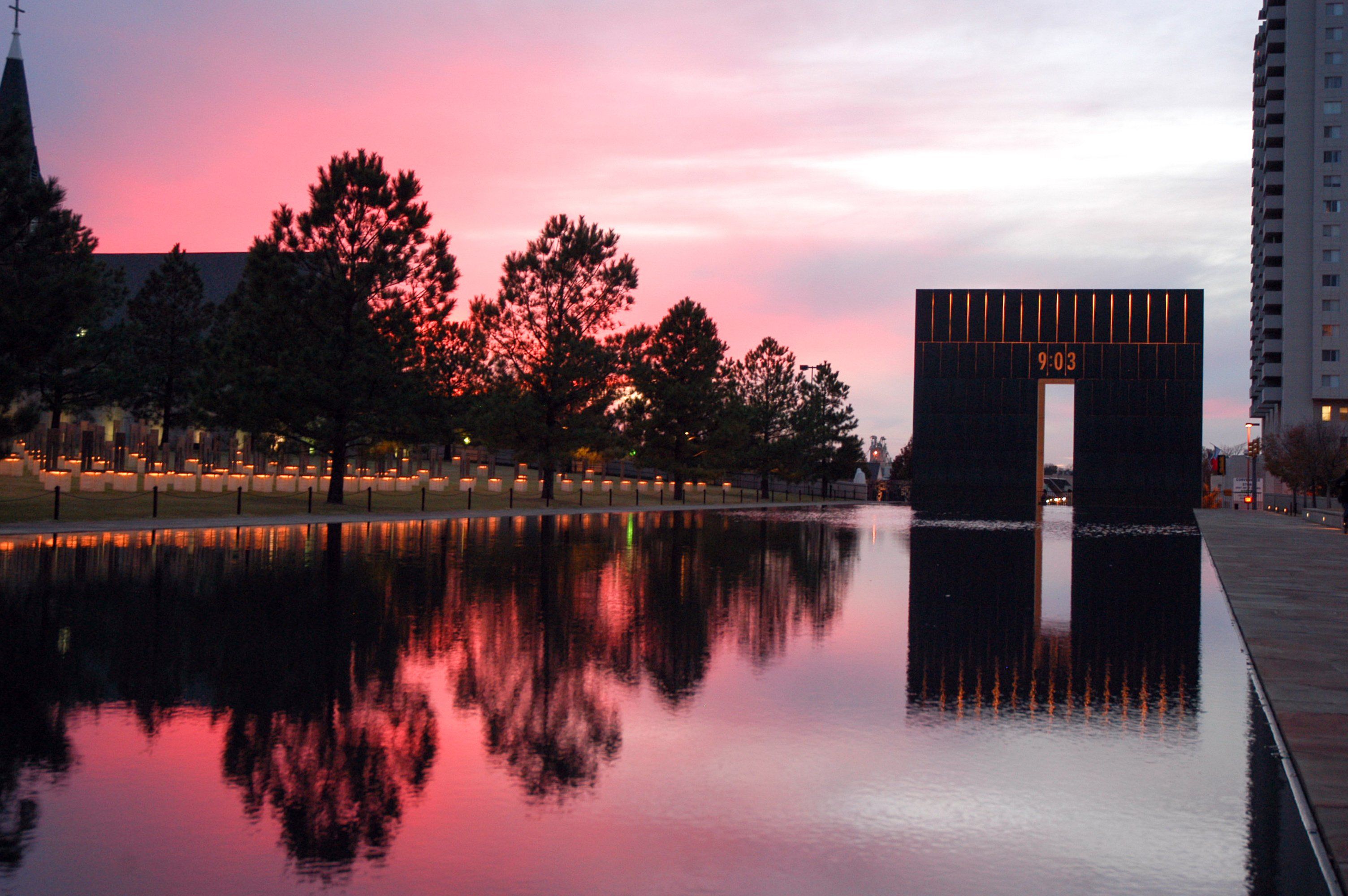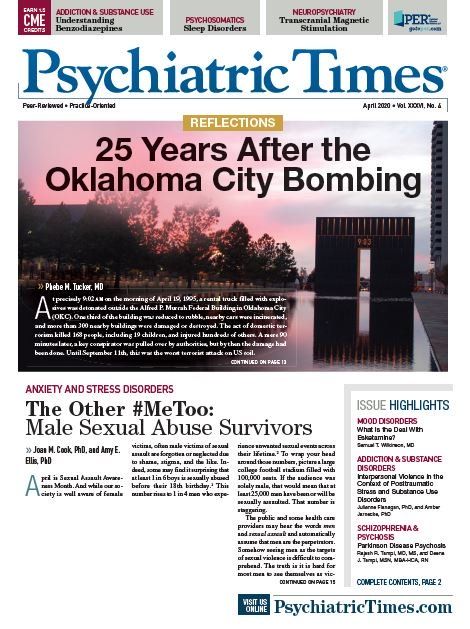Publication
Article
Psychiatric Times
25 Years After the Oklahoma City Bombing
Author(s):
Most of us remember where we were when the terrorist bomb shattered our sense of peace in this usually quiet community. The shockwave travelled for miles and across time.

REFLECTIONS
At precisely 9:02 am on the morning of April 19, 1995, a rental truck filled with explosives was detonated outside the Alfred P. Murrah Federal Building in Oklahoma City (OKC). One third of the building was reduced to rubble, nearby cars were incinerated, and more than 300 nearby buildings were damaged or destroyed. The act of domestic terrorism killed 168 people, including 19 children, and injured hundreds of others. A mere 90 minutes later, a key conspirator was pulled over by authorities, but by then the damage had been done. Until September 11th, this was the worst terrorist attack on US soil.
My story is only one among many accounts by individuals who were touched by the event. Most of us remember where we were when the OKC terrorist bomb shattered our sense of peace in this usually quiet community. The shockwave travelled for miles.
The tragedy unfolds
I recall being in my office less than 2 miles away, supervising a resident, when the entire building shook. Having grown up in the San Francisco Bay Area, my immediate thought was that it was an earthquake. But in Oklahoma, that didn’t make sense. More likely a natural gas explosion, I imagined. My resident, who had attended medical school in Kosovo, later told me that she knew exactly what it was.
We wandered to a room with a TV to see if anything unusual had been reported. A local news channel had their weather helicopter hovering over the downtown area. We watched in disbelief and horror. As the smoke parted, we saw the remains of what we later learned was the Alfred P. Murrah Federal Building, with a large section blown away. My thought at the time was that it would not be possible to survive in this structure, whatever had happened to it. As sometimes occurs, a bomb threat was apparently reported at our University of Oklahoma Health Sciences Center campus, and we dutifully left the building. My contact lenses were unbearable due to invisible dust particles in the air.
Many of my memories from that time are spotty. Later in the day I tried to drive downtown to St Anthony’s Hospital, where many of the physically and emotionally wounded survivors were taken. Traffic leaving the city center was so heavy that I couldn’t proceed on the main route. I turned around, rationalizing that I would be of no help at the bombing site given my small stature, and later felt guilty.
Firefighters, police officers, military personnel, doctors and other volunteers reported to the site to search for survivors-grueling work in an unstable structure surrounded by massive debris. Some medical trainees without disaster experience helped the medical examiners sort out human remains. I went to the local Veterans Affairs Medical Center and met with civilians who had been close to the federal building. Countless community members reported to a local church to help-handling donations of food, bottled water, gloves, and other items to aid rescue and recovery workers. Many OKC residents with relatives and friends in the building and surrounding areas wandered around local hospitals to find loved ones.
Back at our outpatient clinic, we tried to reassure the patients who showed up for mental health care. Whatever problems they had were confounded by fear and sadness at the inexplicable loss of human life so close by. For the next days and weeks, we dealt with the additive effects of the bombing on our patients, and our doors and those of numerous mental health professionals were open to survivors, bereaved individuals, and others who were troubled.
Many of our health and mental health professionals were consumed with recovery work-attending to and doing surgeries on broken bones, head injuries, organ damage, and soft-tissue injuries; and assisting those with mental health sequelae. Psychiatrists and psychologists teamed up with clergy and medical examiners to meet with and notify family members of the deaths of their loved ones. In these sessions, the medical examiner started with a statement about identifying the remains of the loved ones, followed by the mental health care professional and clergy member processing the family members’ reactions. I recall feeling very grateful for the clergy, who had far more experience than I had in processing death and grief.
Media coverage of the bombing was intense, and reporters from across the country flooded the airport to chronicle the event. At some point President Clinton visited to express his condolences. Even actors and celebrities visited to show their support and perhaps boost publicity.
Our governor got tough with insurance companies that were slow in compensating for damages to cars and structures due to an act of civil disturbance. The state local workers compensation laws did not cover mental health sequelae without physical injuries. Fortunately, federal workers compensation benefits covered survivors when only mental health diagnoses occurred due to work-related problems.
Beyond the first days
For weeks and years, we dealt with the aftermath of this event on our community, with people pitching in from all areas of expertise. We were all affected by the tragedy. In addition to the more than 800 injured by the explosion, another 12,000 individuals assisted in extensive rescue efforts, sifting through the destroyed building and surrounding areas for survivors and bodies, caring for those with physical and emotional injuries, transporting and identifying bodies, counseling the bereaved, and performing other duties, many of whom were donating their time. Sadly, there was one fatal injury during the search and rescue operations. In addition to sustaining emotional and physical injuries, many people dealt with unemployment and economic consequences because of barriers to insurance reimbursements and destroyed businesses.
The impact was felt by survivors (adults and children) of direct exposure as well as first responders and family and friends of victims via indirect exposure. Not surprisingly, in a study of 255 who were directly exposed to the blast, about one-third had a PTSD diagnosis.1 About 80% had witnessed death or injuries, and 77% required medical attention.
Seven years later, 26% still suffered from PTSD while many others had subclinical PTSD symptoms.2 Moreover, almost 19 years following the event, another study found that 23.2% of directly exposed survivors met threshold criteria for probable PTSD.3 The study also found that survivors had more anxiety and depression symptoms than controls, and higher symptoms were associated with heavy drinking and worse social functioning.
Children who lost close relatives had greater autonomic reactivity than those who lost more distant relatives, with higher levels of grief associated with more reactivity.4 Study findings suggest that the enduring physiological effects of trauma may be separate from emotional symptoms in children indirectly exposed, representing a lasting footprint of disaster. For instance, seven years after the incident, children of survivors reported relatively low levels of posttraumatic stress and depressive symptoms, but they had more physiological reactivity than a community comparison group.5
First responders seemed to handle the stresses relatively well, which may be partially due to onsite briefings, use of healthy coping techniques (social support and positive reframing), onsite critical stress management, a strong ambiance and sense of community, positive management style, a high educational level, medical experience, and assumption of a professional role.6,7
Learning from disaster
We, in the field of psychiatry, not only helped in the aftermath, but also used this unfortunate event as a learning opportunity. For instance, Art Rousseau, MD, was among several Oklahoma psychiatrists who took a leadership role in organizing mental health recovery efforts, and he was awarded the American Psychiatric Association’s Bruno Lima Award in Disaster Psychiatry for his work. Betty Pfefferbaum, MD, JD, immersed herself in research on effects of the bombing and recovery efforts, especially among children. Her mentorship inspired me to conduct research on biological after-effects among survivors, and long-term health and mental health sequelae. The expertise and contributions of Carol North, MD, MPE, to disaster research have been invaluable.
The Oklahoma State Department of Health worked with physicians and psychiatrists to study physical and emotional injuries. Our research is indebted to many of the survivors who pledged early on to participate in future research; they were passionate about promoting a better understanding of the effects of terrorism on those directly exposed, to help others in similar situations.
Increasingly our communities are affected by diverse disasters-acts of terrorism, mass shootings, destructive wildfires, colossal storms and other catastrophic events. As a global community, it is essential that we share information about interventions that helped survivors, the bereaved, first responders, caregivers and others-and that we give our support. Healing may take many years.
Disclosures:
Dr Tucker is Professor, Arnold and Bess Underman Endowed Chair in Psychiatry, Vice Chair of Education, Department of Psychiatry, University of Oklahoma Health Sciences Center, Oklahoma City, OK.
References:
1. North CS, Nixon SJ, Shariat S, et al. Psychiatric disorders among survivors of the Oklahoma City bombing. JAMA. 1999;282:755-762.
2. North CS, Pfefferbaum B, Kawasaki A, et al. Psychosocial adjustment of directly exposed survivors 7 years after the Oklahoma City bombing. Compr Psychiatry. 2011;52:1-8.
3. Tucker P, Pfefferbaum B, Nitiéma P, et al. Intensely exposed Oklahoma City terrorism survivors: long-term mental health and health needs and posttraumatic growth. J Nerv Ment Dis. 2016;204:203-209.
4. Pfefferbaum B, Tucker P, Jeon-Slaughter H, et al. A pilot study of physiological reactivity in children and maternal figures who lost relatives in a terrorist attack. Death Stud. 2013;37:395-412.
5. Pfefferbaum B, Tucker P, North CS, Jeon-Slaughter H. Physiological reactivity in children of Oklahoma City bombing survivors 7 years postdisaster: a pilot study. Ann Clin Psychiatry. 2011;23:202-207.
6. Tucker P, Pfefferbaum B, Doughty DE, et al. Body handlers after terrorism in Oklahoma City: predictors of posttraumatic stress and other symptoms. Am J Orthopsychiatry. 2002;72:469-475.
7. Nixon SJ, Schorr J, Boudreaux A, Vincent RD. Perceived effects and recovery in Oklahoma City firefighters. J Okla State Med Assoc. 1999;92:172-177.






